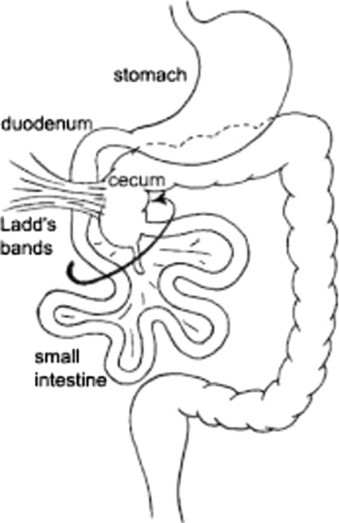Bands of Ladd

Ladd’s bands
Bands of Ladd – Overview
🔹 Definition
Ladd’s bands are peritoneal fibrous bands that extend from the cecum to the right lateral abdominal wall, commonly seen in intestinal malrotation.
🔹 Key Clinical Importance
- They often cross over and compress the duodenum, causing duodenal obstruction.
- Frequently diagnosed in infants and children with bilious vomiting.
- Can cause midgut volvulus, which is a surgical emergency.
🔹 Anatomy & Pathophysiology
- In malrotation, the cecum lies abnormally high and midline or right upper quadrant.
- Fibrous bands (Ladd’s bands) stretch across the duodenum from the cecum to the retroperitoneum.
- This leads to extrinsic compression → duodenal obstruction.
🔹 Clinical Presentation
- Bilious vomiting (greenish, hallmark in neonates).
- Abdominal distension.
- Failure to thrive or feeding intolerance.
- Intermittent or chronic symptoms if partial obstruction.
🔹 Diagnosis
- Upper GI contrast study: “Corkscrew appearance” of midgut volvulus.
- Ultrasound: “Whirlpool sign” of twisted mesentery.
- Abdominal X-ray: Dilated stomach and proximal duodenum (“double bubble” sign).
🔹 Treatment (Ladd’s Procedure)
- Division of Ladd’s bands.
- Widening of mesenteric base to reduce volvulus risk.
- Placement of small intestine on the right and colon on the left.
- Appendectomy (done to avoid future diagnostic confusion).
Ladd’s bands = fibrous peritoneal bands in malrotation causing duodenal obstruction.
What is ‘Bands of Ladd’?
Fibrous stalks of peritoneal tissue that attach the cecum to the retroperitoneum in the right lower quadrant (RLQ)
What are the ‘obstructing Ladd’s Bands’?
Obstructing Ladd’s Bands are associated with malrotation of the intestine, a developmental disorder in which the cecum is found in the right upper quadrant (RUQ), instead of its normal anatomical position in the RLQ.
Ladd’s bands pass over the second part of the duodenum, causing extrinsic compression and obstruction.
What is ‘Ladd procedure’?
Short Questions & Answers – Bands of Ladd
Q1. What are Bands of Ladd?
Bands of Ladd are peritoneal fibrous adhesions that extend from the cecum to the right lateral abdominal wall or retroperitoneum, commonly seen in congenital intestinal malrotation. They often cross the second part of the duodenum, leading to extrinsic duodenal obstruction.
Q2. What is the embryological basis of Bands of Ladd?
They result from abnormal rotation and fixation of the midgut during embryonic development. Normally, the bowel rotates 270° counterclockwise, but in malrotation, incomplete rotation leaves the cecum abnormally positioned, allowing fibrous peritoneal bands (Ladd’s bands) to form.
Q3. What is the main clinical presentation of Ladd’s bands?
The most common presentation is bilious vomiting in neonates and infants, often within the first month of life. Older children may present with intermittent abdominal pain, vomiting, or failure to thrive.
Q4. What complication is most feared in malrotation with Ladd’s bands?
The most dangerous complication is midgut volvulus, where the twisted mesentery compromises blood supply, leading to intestinal ischemia and necrosis. This is a surgical emergency.
Q5. How are Ladd’s bands diagnosed radiologically?
- X-ray: Dilated stomach and proximal duodenum (“double bubble sign”).
- Upper GI contrast study: Corkscrew pattern of twisted bowel.
- Ultrasound: “Whirlpool sign” of mesenteric vessels.
Q6. What is the treatment for Ladd’s bands?
The treatment is Ladd’s procedure, which includes:
- Division of Ladd’s bands.
- Broadening of the mesenteric base.
- Placement of small bowel on the right, colon on the left.
- Appendectomy to prevent future diagnostic confusion.
Q7. Why is appendectomy done during Ladd’s procedure?
Since the appendix is relocated to the left side after rearrangement of the intestines, future appendicitis could confuse diagnosis. Hence, prophylactic appendectomy is always done.
Q8. How does Ladd’s band cause duodenal obstruction?
The fibrous bands cross over the duodenum, mechanically compressing it from outside. This produces partial or complete obstruction, leading to bilious vomiting and gastric distension.
Q9. What is the difference between congenital duodenal atresia and Ladd’s bands obstruction?
- Duodenal atresia: Intrinsic defect → failure of recanalization of duodenum, “double bubble sign” without distal gas.
- Ladd’s bands: Extrinsic compression from fibrous bands, may allow some distal passage of gas.
Q10. What is the prognosis after Ladd’s procedure?
Prognosis is excellent if diagnosed and treated early, with survival rates >90%. Delayed diagnosis with volvulus and bowel necrosis worsens outcomes and may require bowel resection, leading to short bowel syndrome.
Surgical operation
Performed to alleviate intestinal malrotation.
The Ladd procedure involves
- Counterclockwise detorsion of the bowel
- Surgical division of Ladd’s bands
- Widening of the small intestine’s mesentery
- Performing an appendectomy,
- Reorientation of the small bowel on the right and the cecum and colon on the left
Most Ladd surgical repairs take place in infancy or childhood.
Summary: Bands of Ladd
| Point | Summary |
|---|---|
| 1 | Bands of Ladd are peritoneal fibrous adhesions associated with intestinal malrotation. |
| 2 | They extend from the cecum to the right lateral abdominal wall/retroperitoneum. |
| 3 | These bands often cross the second part of the duodenum, causing obstruction. |
| 4 | Result from abnormal midgut rotation (failure of 270° counterclockwise rotation). |
| 5 | Malposition of cecum (often in right upper quadrant) predisposes to band formation. |
| 6 | Commonly present in neonates with bilious vomiting. |
| 7 | Older children may show recurrent abdominal pain, intermittent obstruction, FTT. |
| 8 | The most feared complication is midgut volvulus with bowel ischemia. |
| 9 | Plain X-ray: “Double bubble sign” due to proximal obstruction. |
| 10 | Upper GI contrast study: “Corkscrew appearance” of twisted bowel. |
| 11 | Ultrasound: “Whirlpool sign” of twisted mesenteric vessels. |
| 12 | Differential: duodenal atresia, annular pancreas, pyloric stenosis. |
| 13 | Definitive treatment is Ladd’s procedure. |
| 14 | Ladd’s procedure involves division of Ladd’s bands. |
| 15 | Mesenteric base is widened to prevent volvulus. |
| 16 | Small intestine is placed on the right, colon on the left. |
| 17 | Appendectomy is always done to avoid future diagnostic confusion. |
| 18 | Prognosis excellent if diagnosed and treated early (>90% survival). |
| 19 | Delay with volvulus may require bowel resection → risk of short bowel syndrome. |
| 20 | Early recognition and prompt surgery are lifesaving in neonatal obstruction. |

Bands of Ladd
Bands of Ladd, intestinal malrotation, congenital intestinal obstruction, neonatal bilious vomiting, duodenal obstruction, cecal malposition, midgut volvulus, whirlpool sign ultrasound, corkscrew appearance contrast study, Ladd’s procedure, division of Ladd bands, widened mesenteric base, right-sided small intestine, left-sided colon, neonatal intestinal surgery, congenital GI anomalies, duodenal compression, appendectomy with Ladd’s, short bowel syndrome risk, intestinal ischemia in neonates, surgical management of malrotation.


